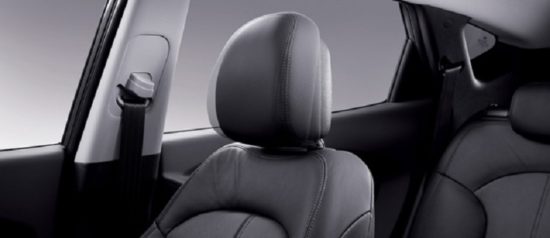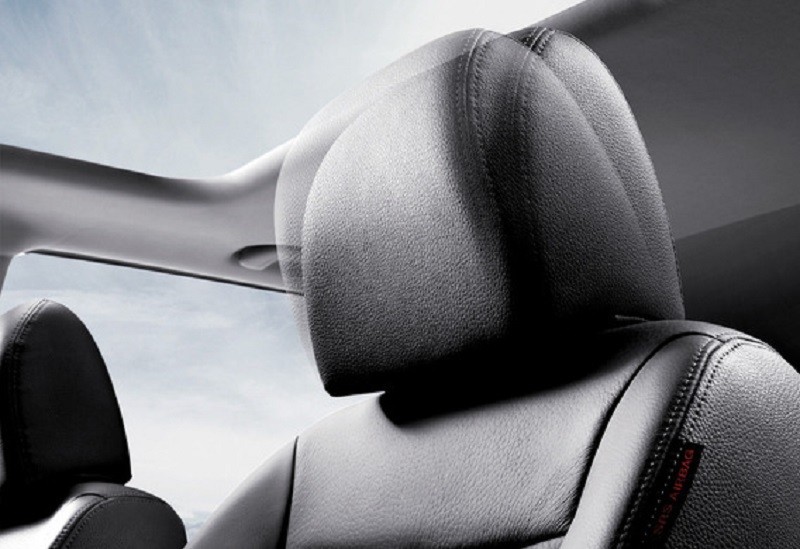With active head restraints had to be found not every motorist. You can see such a security element only on the most modern cars. Many drivers mistakenly consider active head restraints of meaningless money. However, their main purpose is to ensure the safety of the driver (passengers), which active head restraints benefit from the usual (passive) analogues. However, the active head restraints have their drawbacks. About this further in the article.
Content
Active headrests what it is
Imagine such a picture. In the back of your car enters another car. By inertia, your body begins to move back. Head and neck, like a whip, accelerates and rush to hit the head restraint. At this time, an invisible hand appears behind the head, picking his head and holding it in the most safe position.
In fact, all car owners are accustomed to passive variations of head restraints, which, for some time ago, there was simply an alternative. Of course, passive head restraints every car enthusiast can be tuned to themselves - lift them or lower them. However, when driving, this component remains completely passive, which does not always make it possible to protect against unpleasant consequences.
Therefore, the designers developed a system of active head restraints, not just holding the head when hit, and approaching it during a strong collision. Thanks to this, the risk of getting a spinal injury is decreasing ten times. In their favor, the real numbers collected in the results of real emergencies and crash tests.
What tasks are facing active head restraints
The main task of active head restraints - as quickly as possible to provide your head with a support that reduces the possible injuries of the spine and neck to zero when an emergency occurrence. According to its device, active head restraints are two types:
- Electric.
- Mechanical.
Mechanical active headrests, device and principle of operation
Mechanical variations of active head restraints are simple enough. The seat is built into the lever, which is connected to the headrest. During the accident, the spin of a person is strongly pressed into the seat, which is why this lever is pressed and the head restraint begins to move towards the head. When the pressure is weakened on the seat back, the spring returns the head restraint back. The larger the pressure will have a spin chair, the faster the system will work.
Electric active head restraints, device and principle
Electrical active headrests require the presence of a system control unit, shock sensors and a lever mechanism that leads the head restraint into action. The basis of the lever mechanism is a sopatron. The shock sensors are located in the back of the car. Signals from the sensors come to the control unit, which, based on the direction and strength of the blow, performs the adjustment of the operation of the lever mechanism. Electrical type systems are more expensive than mechanical fellow, but their effectiveness is much higher. Although even the most simple active head restraints significantly increase the level of passive safety of the vehicle.
What is the passive safety of the car
Modern vehicle is a source of increased danger. The steady increase in the speed and power of the car, as well as the density of the movement of automotive streams, significantly increase the likelihood of an emergency. To protect passengers in the conditions of the accident, technical safety devices are actively developed.
The combination of the structural components used to protect people in the cabin, from injuries with an accident, forms a system of passive vehicle safety. The system provides protection not only for a particular car and passengers in it, and other participants in the road.
The most important elements of the car passive security system are:
- Seat belts.
- Active headrests.
- Safety belts tensioners.
- Airbags.
- Emergency battery broker.

- Safe body design.
- Pedestrian protection system (modern development).
- Emergency call system.
- Other devices (protection when tilting in the cabriolet, security systems for children - seat belts, chairs, fasteners).
Advantages and disadvantages of active head restraints
The great advantage of active head restraints is no need to constantly adjust them, in comparison with fixed analogues in need of diligent tuning in height. The active head restraints are calculated on ordinary human dimensions and set them up in height only in the case when a thin man sits down in the chair or, on the contrary, a diluted and low.
However, despite the benefit that they bring, active head restraints can deliver and trouble. For example, many car owners complain that with the smallest presses on the back of the seat, the lever mechanism works and they get a headrest on the head. Or the guides of this mechanism are resting in the back. Dealers actually always recognize the defect "not warranty", motivating that "they have so on all cars." Some drivers get used to the gentle behavior of the mechanism, while others are forced to eliminate the breakdown at their own expense.
Another frequent problem is a breakdown of the retainer or knots of the lever mechanism. As a rule, this happens as a result of the use of low-quality materials. The reason may also serve as an incorrect assembly technology. To cure such a defect is most likely, you will not succeed. Therefore, if the car is warranty, require a dealer to replace the seat.
Council Prof.
The average cost of active head restraints varies within 2000-5000 rubles. According to statistics, head restraints are able to save injuries in thirty percent of an accident with a collision from behind. And now think how much you evaluate the safety of your own neck? Do not save on your health. If you have the ability to equip your car with such a system - do it.
Related Materials
- Stove 2110, bad warm stove 2110, VAZ 2110 heating system, repairing the heating system VAZ 2110 with their own hands
- VAZ 2114 stove blows with cold air, stove 2114, bad warm stove VAZ 2114, device and repair of heating VAZ 2114 do-it-yourself, removing the stove VAZ 2114
- How to subdominize the car. How to put a jack. Types of jacks for cars.
- VAZ 2109 Fuse Block, VAZ 2109 Fuse Block Carburetor, VAZ 2109 Fuse Block Injector, Old VAZ 2109 Fuse Block, VAZ 2109 Fuse Block, VAZ Fuse Block 2109
- Car exhaust gas catalyst, faulty catalyst, pluses and cons of the catalyst, how to change the catalyst for the planeencitel
- Stove blowing cold air VAZ 2114, badly blowing the stove VAZ 2114, why badly blowing the stove VAZ 2114
- How to find out the owner of the car by the number of his car, check the car by the number of the traffic police machine, check the car by the state number of the car for free
- How to choose Used tires, Useful Tips
- Winter car road, pressure in passenger car tires in winter, good battery for the car in winter, whether to warm the car in winter
- In winter, the car is poorly started. How to make a car in winter, do you need to warm up the car in winter, useful tips
- Economy fuel consumption machines, the most economical car consumption
- Tires brands for passenger cars, labeling of car tire labeling, residual passenger car tire protector, how to pick a tire on a car brand, car tire tread pattern
- Working transmission operation, mechanical gearbox clutch work, driving with manual gearbox, useful tips
- Rear beam Peugeot 206 sedan, rear beam device Peugeot 206. Rear beam Peugeot 206 Malfunction, repair of the rear beam Peugeot 206
- Diesel fuel in winter, additive for diesel fuel in winter, how to choose the best diesel fuel
- Diesel winter does not start. How to start diesel in winter, heating diesel in winter.
- Japanese bridgestone tires, winter studded bridgestone tires, bridgestone tires brand
- Tire marking decoding for passenger cars, labeling wheels, how to choose the right tires on the disks
- Diesel engine in winter, launch of the diesel engine in winter, what oil to fill in a diesel engine in winter, useful tips
- LED backlight of the car, the backlight of the bottom of the car, the backlight of the legs in the car, the backlight in the door of the car, the backlight of the car is fine
- Recovered tires, bus tire, restored tire protector, can I use them
- Choose winter tires, which is a winter tires, which pressure in winter tires should be marked with winter tires, how to choose the right winter tires, the best winter tires 2019
- Steering rail rail, knock of steering rack, reasons for the knock and repair of the steering rack do it yourself
- Cameless car tires, a set for repair of tubeless tires, repair of the cannon-free tire do it yourself
- Russian tires, Russian tires Winter, Russian All-season tires, Voronezh AMTEL tires, Tires "Matador Omsk Tire", Kama-tires are world-class bus
- How to open a car without a key. Lost the key from the car what to do, the key from the car inside the car
- Silent tires, quiet winter tires, quiet studded bus, which tires to choose, overview tires
- Tires and safety, safety of the bus, why it is necessary to constantly monitor car tires
- Rules of safe driving of the car in the rain and slush, safe driving of the car for beginners
- Rust converter which is better for cars, rust converters to choose how to use rust transducer, professionals
- Polishing the body of the car do it yourself, how to choose a polishing paste, useful tips
- Engine durability, engine life, how to extend engine life
- Knock in the car. Knock when moving a car. What can knock in the car. How to determine the cause of the knock.
- ABS car, what is ABS car, ABS system malfunction, ABS diagnostics
- Overtaking a car when you can start overtaking a car, rules of traffic rules
- Fuel pump VAZ 2110, VAZ 2110 gas station scheme, VAZ 2110 fuel pump device, VAZ 2110 gas station repair,
- Automotive antennas for radio, automotive antenna device, car antenna do it yourself
- Front suspension Kalina, device front suspension Kalina, knock in front suspension Kalina, repair of front suspension Kalina
- Shock absorber Oil, best oil shock absorbers, pumping oil shock absorbers, how to properly pump oil shock absorber
- Clutch malfunctions, touches clutch, causes a clutch malfunction, how to eliminate




















Comments